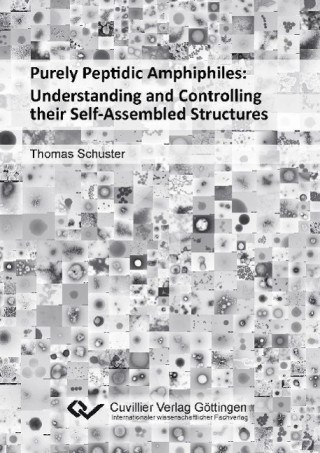
Kod: 13414737
Purely Peptidic Amphiphiles: Understanding and Controlling their Self-Assembled Structures
Autor Thomas Schuster
Amphiphilic molecules spontaneously self-assemble into a variety of structures in solution. The term amphiphilic indicates that one part of the molecule is attracted to the solvent, while the other is not. Interactions such as bet ... więcej
- Język:
 Angielski
Angielski - Oprawa: Miękka
- Liczba stron: 138
Wydawca: Cuvillier Verlag, 2011
- Więcej informacji o książce

94.74 zł
Zwykle: 99.69 zł
Oszczędzasz 4.96 zł

Dostępna u dostawcy
Wysyłamy za 5 - 7 dni
Zobacz książki o podobnej tematyce
-

NIKE
57.48 zł
Podaruj tę książkę jeszcze dziś
- Zamów książkę i wybierz "Wyślij jako prezent".
- Natychmiast wyślemy Ci bon podarunkowy, który możesz przekazać adresatowi prezentu.
- Książka zostanie wysłana do adresata, a Ty o nic nie musisz się martwić.
Więcej informacji o Purely Peptidic Amphiphiles: Understanding and Controlling their Self-Assembled Structures
Za ten zakup dostaniesz 55 punkty
 Opis
Opis
Amphiphilic molecules spontaneously self-assemble into a variety of structures in solution. The term amphiphilic indicates that one part of the molecule is attracted to the solvent, while the other is not. Interactions such as between solute-solvent and solute-solute thus determine the organization. Understanding the self-assembly means understanding those interactions and their driving forces. In the first chapter an overview of the self-organization of amphiphilic molecules into supermolecuar aggregates of different morphologies is provided, with a focus on purely peptidic amphiphiles, i.e. amphiphiles which consist solely of a different amino acid sequence. In the second chapter the self-assembly of amphiphilic peptides with a specific amino acid sequence into micelles and spherical peptide nanoparticles is described. The undecamer peptide that was used features a repetitive L-tryptophan and D-leucine [LW-DL] motif, representing the hydrophobic block - which is a truncated version of gramicidin A (gA), named gT. The N-terminally attached hydrophilic section was either lysine (K) or acetylated lysine (X) and was optionally terminated with cysteine for post-functionalization of the thiol-group. The uncharged peptide AcC-X3-gT was demonstrated to assemble into micelles and subsequently into peptide particles, termed żpeptide beads'. We hypothesize that the peptide beads consisted of micelles - a structure described as multicompartment micelles. Peptide beads using AcC-X3-gT and its analogues - including Ac-X3-gT-C, a new peptide with the cysteine residue on the C instead of the N-terminus - are further investigated in Chapter Three. We succeeded in creating highly ordered Ac-X3-gT-C - Au-NP composites, which allowed us to visualize the inner structure of the nanoparticles. The presented composite materials are expected to exhibit exceptional electrical and optical properties. In Chapter Four these amphiphilic peptides are studied with regard to the interaction within a lipid layer but also in pure peptide layers at the air-water interface. Results indicate the formation of a unimolecular, flat film. Peptide layers were successfully transferred onto a solid support or self-assembled peptide monolayers (SAMs) were created equally well via immersion and spin-coating. Preliminary mineralization experiments confirmed the successful creation of calcium phosphate crystals. The topic of the following chapter focuses on a peptide library that has been synthesized to correlate the primary sequence, its secondary structure and the resulting self-assembly. The peptide design includes three parts: (a) a charged lysine part, (b) an acetylated lysine part and (c) a constant hydrophobic rod-like helix, based on gramicidin A (gA). By stepwise replacement of free lysine (K) with acetylated lysine (X) we generated a library of a total of ten peptides Ac-X8-gA and KmX8-m-gA (m ranging from 0 to 8). By using point mutations, we adjusted the degree of acetylation (DA) and thus the overall amphiphilicity of the peptides, which led to a change in the secondary structure in the aqueous environment from a ?-sheet to an ? -helix. This transition generated a significant change in the morphology of the self-assembled structures from fibers to micelles. The study is important precisely because it presents a first step towards molecular switches based on acetylation of a peptide, inspired by the example of phosphorylation of proteins or enzymes, which converts them into the active or inactive state by structural changes. Chapter Seven focuses on essential parameters to successfully manage membrane formation from a purely peptidic system. A crucial step in the formation of peptide membranes appears to be dimerization, which originates from the introduction of intermolecular interactions, such as H-bonds or ??? stacking of aromatic rings. The formation of a stabilized membrane subunit, i.e. dimers in the lateral or perpendicular directions (relative to the membrane) produced stable, purely peptidic vesicles and may well apply to other peptidic systems. These novel peptidic systems offer hydrophilic and hydrophobic compartments to encapsulate and integrate different drugs or payloads and could be used for gene delivery, since the design includes charged moieties. In the last chapter, the achievements of the presented work are discussed and summarized. Furthermore, lines of research are suggested, which, from the present point of view, appear to be the most promising and should be the focus of subsequent experiments.
 Szczegóły książki
Szczegóły książki
94.74 zł
- Pełny tytuł: Purely Peptidic Amphiphiles: Understanding and Controlling their Self-Assembled Structures
- Autor: Thomas Schuster
- Język:
 Angielski
Angielski - Oprawa: Miękka
- Liczba stron: 138
- EAN: 9783869557977
- ISBN: 3869557974
- ID: 13414737
- Wydawca: Cuvillier Verlag
- Waga: 189 g
- Wymiary: 210 × 148 × 7 mm
- Data wydania: 05. July 2011
Ulubione w innej kategorii
-

Dune
34.83 zł -33 % -

Haunting Adeline
125.75 zł -1 % -

Berserk Deluxe Volume 2
212.54 zł -1 % -

White Nights
15.29 zł -23 % -

Powerless
48.72 zł -11 % -

Atomic Habits
57.48 zł -28 % -

Dune Messiah
46.31 zł -3 % -

Berserk Deluxe Volume 3
218.08 zł -3 % -

One Day
32.61 zł -36 % -

Berserk Deluxe Volume 1
211.73 zł -2 % -

Iron Flame
61.11 zł -28 % -

Surrounded by Idiots
36.74 zł -28 % -

Harry Potter and the Prisoner of Azkaban (Minalima Edition)
170.35 zł -2 % -

Gravity Falls Journal 3
89.40 zł -

Heaven Official's Blessing: Tian Guan Ci Fu (Novel) Vol. 1
85.57 zł -5 % -

The Creative Act
100.17 zł -15 % -

Dune
47.31 zł -23 % -

Hunting Adeline
126.45 zł -4 % -

A Little Life
47.01 zł -14 % -

Children of Dune
46.71 zł -2 % -

Heaven Official's Blessing: Tian Guan Ci Fu (Novel) Vol. 2
77.72 zł -14 % -

Bungo Stray Dogs, Vol. 8 (light novel)
65.74 zł -4 % -

Percy Jackson and the Olympians 5 Book Paperback Boxed Set
185.45 zł -4 % -

Solo Leveling, Vol. 1
86.68 zł -3 % -

The Prisoner's Throne
44.90 zł -12 % -

Court of Thorns and Roses
43.39 zł -15 % -

Cry Baby Coloring Book
47.31 zł -1 % -

Fourth Wing
73.89 zł -12 % -

Icebreaker
35.13 zł -26 % -

Berserk Deluxe Volume 6
218.08 zł -3 % -

Avatar, the Last Airbender: The Kyoshi Novels (Box Set)
169.14 zł -2 % -

The 48 Laws of Power
100.88 zł -12 % -

House of Leaves
124.04 zł -3 % -

Twisted Lies
37.75 zł -26 % -

Dune Messiah
49.63 zł -13 % -

No Longer Human
58.49 zł -5 % -

48 Laws Of Power
61.11 zł -28 % -

Twisted Games
37.75 zł -26 % -

Caraval Paperback Boxed Set
175.49 zł -3 % -

Solo Leveling, Vol. 2
80.34 zł -17 % -

Open Circuits
169.55 zł -2 % -

Berserk Deluxe Volume 5
156.46 zł -30 % -

Heaven Official's Blessing: Tian Guan Ci Fu (Novel) Vol. 3
79.43 zł -12 % -

Berserk Deluxe Volume 4
201.26 zł -11 % -

Court of Mist and Fury
36.54 zł -26 % -

SOLO LEVELING V08
88.39 zł -2 % -

English File Upper Intermediate Multipack A (4th)
100.57 zł -

CHAINSAW MAN V14
43.59 zł -21 % -

Before the Coffee Gets Cold
33.92 zł -26 %
zadowolonych klientów
Od roku 2008 obsłużyliśmy wielu miłośników książek, ale dla nas każdy był tym wyjątkowym.
Copyright! ©2008-24 libristo.pl Wszelkie prawa zastrzeżonePrywatnieCookies


 21 milionów książek
21 milionów książek Dostawa 10.99 zł
Dostawa 10.99 zł (32) 444 93 66 (8-15.30h)
(32) 444 93 66 (8-15.30h)